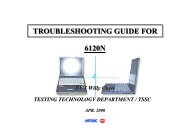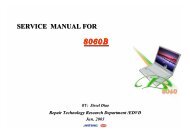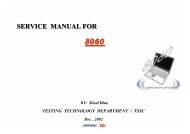Mitac 8080 Service Manual - laptop schematics, notebook ...
Mitac 8080 Service Manual - laptop schematics, notebook ...
Mitac 8080 Service Manual - laptop schematics, notebook ...
You also want an ePaper? Increase the reach of your titles
YUMPU automatically turns print PDFs into web optimized ePapers that Google loves.
<strong>8080</strong> N/B Maintenance<br />
5.3 Intel 82801DBM I/O Controller Hub 4 Mobile (ICH4-M)<br />
IDE Interface Signals (Continued)<br />
Signal Name Type Description<br />
PIORDY#/<br />
(PDRSTB/PWDMA<br />
RDY#)<br />
SIORDY#/<br />
(SDRSTB/SWDMA<br />
RDY#)<br />
I Primary and Secondary I/O Channel Ready (PIO): This signal<br />
will keep the strobe active (PDIOR# or SDIOR# on reads, PDIOW#<br />
or SDIOW# on writes) longer than the minimum width. It adds wait<br />
states to PIO transfers.<br />
Primary and Secondary Disk Read Strobe (Ultra DMA Reads from<br />
Disk): When reading from disk, the ICH4 latches data on rising and<br />
falling edges of this signal from the disk.<br />
Primary and Secondary Disk DMA Ready (Ultra DMA Writes to<br />
Disk): When writing to disk, this is de-asserted by the disk to pause<br />
burst data transfers.<br />
Interrupt Signals<br />
Signal Name Type Description<br />
SERIRQ I/O Serial Interrupt Request: This pin implements the serial interrupt<br />
protocol.<br />
PIRQ[D:A]# I/OD PCI Interrupt Requests: In Non-APIC Mode the PIRQx# signals<br />
can be routed to interrupts 3, 4, 5, 6, 7, 9, 10, 11, 12, 14 or 15 as<br />
described in the Interrupt Steering section. Each PIRQx# line has a<br />
separate Route Control Register.<br />
In APIC mode, these signals are connected to the internal I/O APIC<br />
in the following fashion: PIRQ[A]# is connected to IRQ16,<br />
PIRQ[B]# to IRQ17, PIRQ[C]# to IRQ18, and PIRQ[D]# to IRQ19.<br />
PIRQ[H:E]#/<br />
GPIO[5:2]<br />
This frees the legacy interrupts.<br />
I/OD PCI Interrupt Requests: In Non-APIC Mode the PIRQx# signals<br />
can be routed to interrupts 3, 4, 5, 6, 7, 9, 10, 11, 12, 14 or 15 as<br />
described in the Interrupt Steering section. Each PIRQx# line has a<br />
separate Route Control Register.<br />
In APIC mode, these signals are connected to the internal I/O APIC<br />
in the following fashion: PIRQ[E]# is connected to IRQ20,<br />
PIRQ[F]# to IRQ21, PIRQ[G]# to IRQ22, and PIRQ[H]# to IRQ23.<br />
This frees the legacy interrupts. If not needed for interrupts, these<br />
signals can be used as GPIO.<br />
IRQ[14:15] I Interrupt Request 14:15: These interrupt inputs are connected to<br />
the IDE drives. IRQ14 is used by the drives connected to the<br />
Primary controller and IRQ15 is used by the drives connected to the<br />
Secondary controller.<br />
APICCLK I APIC Clock: This clock operates up to 33.33 MHz.<br />
APICD[1:0] I/OD APIC Data: These bi-directional open drain signals are used to<br />
send and receive data over the APIC bus. As inputs the data is valid<br />
on the rising edge of APICCLK. As outputs, new data is driven<br />
from the rising edge of the APICCLK.<br />
LPC Interface Signals<br />
Signal Name Type Description<br />
LAD[3:0]/<br />
I/O LPC Multiplexed Command, Address, Data: For the LAD[3:0]<br />
FWH[3:0]<br />
signals, internal pull-ups are provided.<br />
LFRAME#/<br />
O LPC Frame: LFRAME# indicates the start of an LPC cycle, or an<br />
FWH[4]<br />
abort.<br />
LDRQ[1:0]# I LPC Serial DMA/Master Request Inputs: LDRQ[1:0]# are used<br />
to request DMA or bus master access. These signals are typically<br />
connected to an external Super I/O device. An internal pull-up<br />
resistor is provided on these signals.<br />
USB Interface Signals<br />
Signal Name Type Description<br />
USBP0P,<br />
USBP0N,<br />
USBP1P,<br />
USBP1N<br />
USBP2P,<br />
USBP2N,<br />
USBP3P,<br />
USBP3N<br />
USBP4P,<br />
USBP4N,<br />
USBP5P,<br />
USBP4N<br />
I/O Universal Serial Bus Port 1:0 Differential: These differential<br />
pairs are used to transmit data/address/command signals for ports 0<br />
and 1. These ports can be routed to USB UHCI Controller #1 or the<br />
USB EHCI Controller.<br />
NOTE: No external resistors are required on these signals. The<br />
ICH4 integrates 15 k . pull-downs and provides an output driver<br />
impedance of 45 . which requires no external series resistor<br />
I/O Universal Serial Bus Port 3:2 Differential: These differential<br />
pairs are used to transmit data/address/command signals for ports 2<br />
and 3. These ports can be routed to USB UHCI Controller #2 or the<br />
USB EHCI Controller.<br />
NOTE: No external resistors are required on these signals. The<br />
ICH4 integrates 15 k . pull-downs and provides an output driver<br />
impedance of 45 . which requires no external series resistor.<br />
I/O Universal Serial Bus Port 5:4 Differential: These differential<br />
pairs are used to transmit data/address/command signals for ports 4<br />
and 5. These ports can be routed to USB UHCI Controller #3 or the<br />
USB EHCI Controller<br />
NOTE: No external resistors are required on these signals. The<br />
ICH4 integrates 15 k . pull-downs and provides an output driver<br />
impedance of 45 . which requires no external series resistor<br />
OC[5:0]# I/O Overcurrent Indicators: These signals set corresponding bits in<br />
the USB controllers to indicate that an overcurrent condition has<br />
occurred.<br />
USBRBIAS O USB Resistor Bias: Analog connection point for an external<br />
resistor to ground. USBRBIAS should be connected to<br />
USBRBIAS# as close to the resistor as possible.<br />
USBRBIAS# I USB Resistor Bias Complement: Analog connection point for an<br />
external resistor to ground. USBRBIAS# should be connected to<br />
USBRBIAS as close to the resistor as possible.<br />
93





